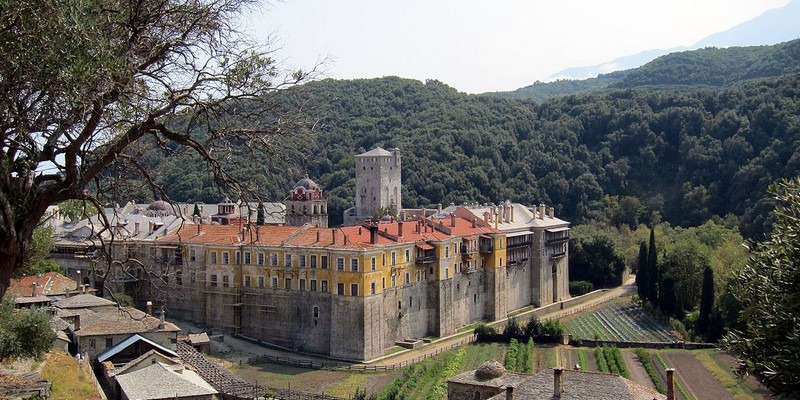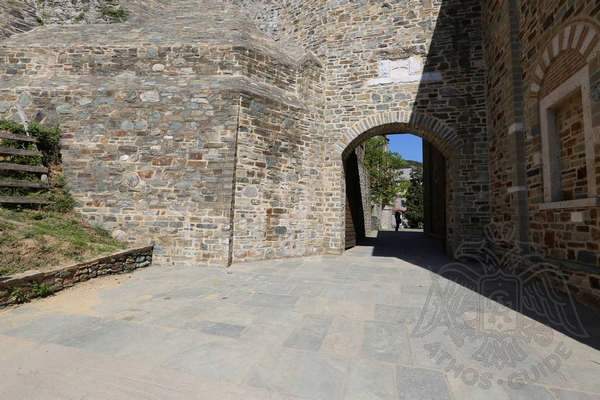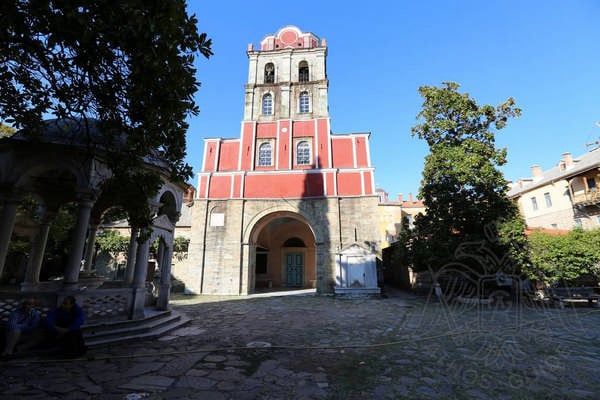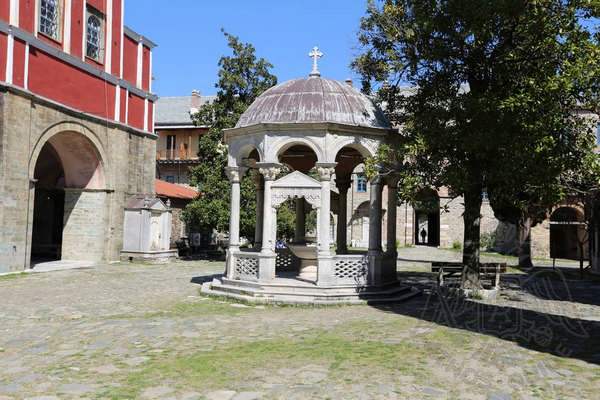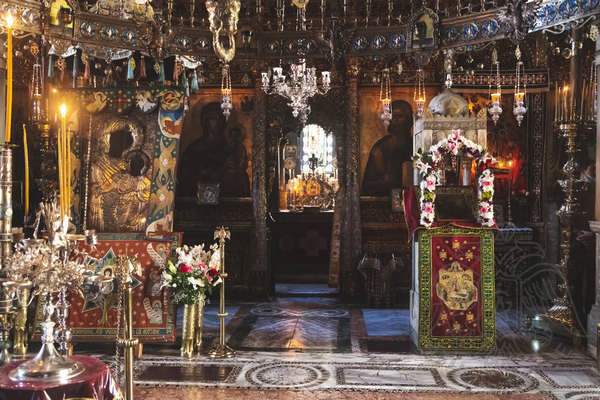History and present days
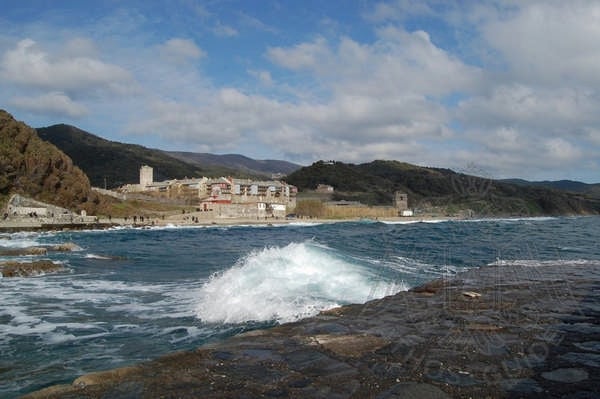
The Monastery of Iviron dominates the wide coastline formed by the torrent of the Iviritic Lakkos. In the background, one can distinguish the colorful roofs of the houses in Karyes, the domes of Serai and the Monastery of Koutloumousiou.
On the slopes to the left of the monastery, there is the dome of the katholikon of the Skete of Saint John the Forerunner. Higher up there is a cell near the cave where Saint Gabriel the Iberian used to live as an ascetic. He is known for the vision he had on the arrival of the icon of Theotokos Portaitissa, the patron icon of the monastery. He also walked on the sea to receive it and bring it ashore. At the spot where Saint Gabriel placed the icon on land, a water spring immediately gushed forth. Today, one can still find in the same place the holy water of Theotokos Portaitissa. This spring is located near the fishermen’s house on the southern side of the beach.
The latter (early 19th century) has six vaulted boat shelters on the ground floor and a number of living quarters on the upper floor. It is particularly noteworthy regarding its architecture, while it is still in use by the monastery's fishermen. It was here that Fotis Kontoglou stayed when he visited Mount Athos in 1923.
There are six cells in front of the arsanas, while there is also a covered balcony leaning on beams of wildwood. We slept there. Underneath, it had some low arches, where they pulled the boats. The nets were spread over the logs. While we slept, we could hear the sea below us, coming in through the arches, rolling the gravel and lulling us to sleep. Old icons were hung in the arsanas and a sleepless candle was always burning. (Fotis Kontoglou, Summer on Mount Athos, 1923)
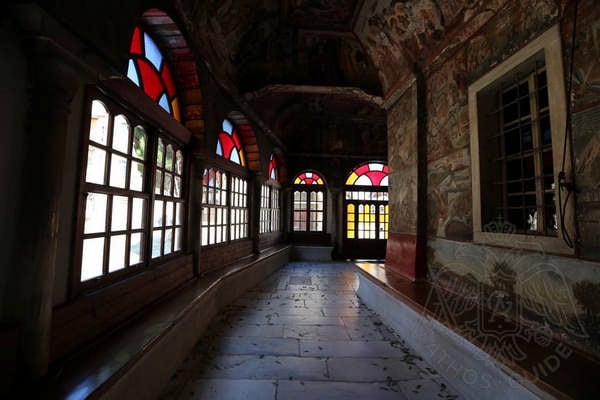
Inside the courtyard lies the kathisma of Theotokos Portaitissa. It includes a church and a cell, where, in July 2003, the Metropolitan of Thessaloniki, Panteleimon II, was buried. There, in the sanctuary, ends the procession of the holy icon on the Feast of Epiphany. The consecration of the waters, as is performed traditionally in the orthodox church, takes place in the same spot. Nearby, it is believed that the Virgin Mary arrived and requested Christ to grant her the Athonite peninsula as her earthly heritage.
Opposite the monastery, on the wooded hill, there is the Cell of Prophet Elijah, the birthplace of the martyr patriarch Gregory V. The large independent building between the monastery and the hill is a cemetery church (Saint Athanasios the Great, 1672).
Its ceiling is adorned with great decoration, in accordance with the baroque style that was popular at that time in Mount Athos. The wood-carved gilded iconostasis is particularly impressive. The icons of Saint Athanasios, Christ the Philanthropist and the Virgin Mary date from 1680. Below the church, there is the ossuary.
The impressive tower of the arsanas has preserved all its architectural elements. It was built in 1626, together with a chapel dedicated to the Holy Three Children in the furnace and to Prophet Daniel. The expenses were covered by Galation, the former Metropolitan of Elassona. It is said that the tower was connected to the monastery through an underground tunnel that led to the chapel of Saint John the Forerunner. Today, the tower has been restored. Its ground floor houses the monastery's carpentry workshop. A chapel dedicated to the fathers of the monastery (George, Efthimios, John) was later built at its western entrance.
The monastery’s floor plan has a quadrilateral shape. The wings date from different periods. The strong fortification character of the building complex is highlighted by the balconies and the carvings on the eastern side that faces the sea. In contrast, the west, north and south facades, which lack balconies, present a symmetrical uniformity with elements of a neoclassical design.
History
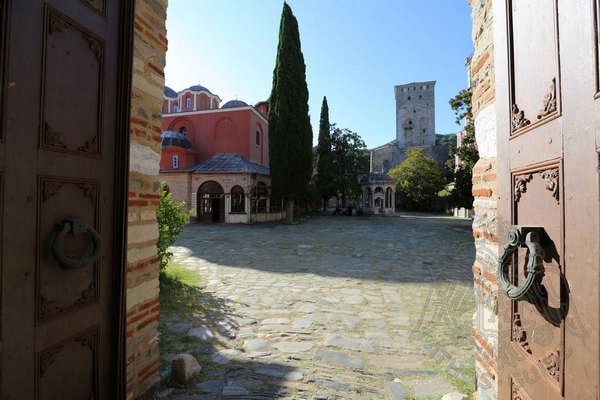
On the site of the Monastery of Iviron, there was once the ancient Monastery of Clement. Its foundation (8th century) is associated with the Emperor Constantine IV Pogonatos. According to tradition, in the 3rd century, the Patriarch of Jerusalem, Clement, arrived there and christianized the Pagans. The monastery was built around the church of Saint John the Forerunner, which is traditionally one of the oldest churches in Mount Athos. It was constructed by Constantine the Great on a sanctuary of Poseidon. However, archaeological excavations, conducted at a depth of 8 meters from the floor of the temple, have failed to uncover any evidence of that ancient sanctuary.
The foundation of the monastery dates back to the period 980-985 and is associated with two monks from Iberia, who had served as advisors to the King of Georgia, David III Kuropalates. They had lived in solitude at the Monastery of Great Lavra, along with their fellow monks. During the reign of Basil II the Bulgar Slayer (976-1025), the Georgian monks, requested the emperor's permission to establish their own monastery, due to a lack of space. With the consent of Basil II, they acquired several monasteries in exchange for two Georgian monasteries in Constantinople and Trebizond. Thus, the Monastery of Iviron was established near the Monastery of Great Lavra, which explains the close relationship between the two communities, as well as the custom of having a representative of each monastery in each feast. In 985, the Monastery of Iviron was granted a chrysobull giving it the privilege of owning a large ship.
In 1034, the monastery received several donations of land from the Emperor Michael IV Paphlagon (1034-1041). In the Typikon of Constantine Monomachos (1046), the monastery occupies the fourth rank in the Athonite hierarchy. It reached its peak of prosperity between 1051 and 1072. During this time, the Bible and numerous ecclesiastical texts were translated into Georgian, while a school (likely identical to the now-ruined Cell of Saint John the Theologian) was founded.
The monastery was destroyed during the reign of Michael VIII Palaiologos and the Latin Patriarch Vecchus. The monks resisted the union with the Church of Rome sought by the emperor. Many of them became martyrs. The monastery was also plundered by Catalan and Arab pirates in the late 13th and early 14th centuries. The reconstruction of the community was aided by the Serbian King Stefan Dušan and the ruler of Georgia, Gorgoranis. 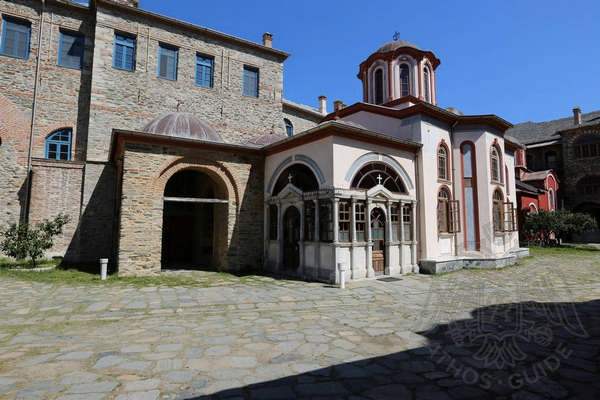 Over time, the Greek monks became more than the Georgians. Thus, in 1357, by a decree of the Patriarch Kallistos I, the monastery passed into Greek authority. It was also desided that services should be conducted in Greek. However, the ties with Georgia did not fade. Georgian rulers continued to help with the construction of towers, the domes of the katholikon and the exonarthex, while they also dedicated to the monastery a great number of metochia. The last Georgian monk passed away in 1955. The reestablishment of the Iviritic community, taking place during the 14th century, was followed by a period of prosperity until the late 16th century, when the monastery faced significant financial problems. With the help of the Georgian ruler Alexander VI, it overcame all difficulties, expanded its buildings and increased the number of monks. In the mid-17th century, at the request of the Tsar Alexis (1645-1677), Iberian monks brought a copy of the icon of Theotokos Portaitissa to Moscow. Through its miraculous powers, the Tsar’s daughter was cured from a serious disease. In gratitude, the Tsar granted the Monastery of Saint Nicholas in Moscow to the Monastery of Iviron. The assistance of Moldavian rulers, such as Serban Kantakouzenos, and numerous patriarchs, has also been of great importance. In 1804, the building complex was extended to the west. In 1863, the monastery was severely damaged by fire.
Over time, the Greek monks became more than the Georgians. Thus, in 1357, by a decree of the Patriarch Kallistos I, the monastery passed into Greek authority. It was also desided that services should be conducted in Greek. However, the ties with Georgia did not fade. Georgian rulers continued to help with the construction of towers, the domes of the katholikon and the exonarthex, while they also dedicated to the monastery a great number of metochia. The last Georgian monk passed away in 1955. The reestablishment of the Iviritic community, taking place during the 14th century, was followed by a period of prosperity until the late 16th century, when the monastery faced significant financial problems. With the help of the Georgian ruler Alexander VI, it overcame all difficulties, expanded its buildings and increased the number of monks. In the mid-17th century, at the request of the Tsar Alexis (1645-1677), Iberian monks brought a copy of the icon of Theotokos Portaitissa to Moscow. Through its miraculous powers, the Tsar’s daughter was cured from a serious disease. In gratitude, the Tsar granted the Monastery of Saint Nicholas in Moscow to the Monastery of Iviron. The assistance of Moldavian rulers, such as Serban Kantakouzenos, and numerous patriarchs, has also been of great importance. In 1804, the building complex was extended to the west. In 1863, the monastery was severely damaged by fire.
For many centuries, the monastery had a unique structure. It was restored to the cenobitic system in 1990 when it was manned by a group of monks under the Archimandrite Basil.
The Monastery of Iviron was home to Saint Cosmas and Peter, who martyred shortly after the fall of Constantinople (1453). Additionally, the Holy Neomartyr Constantine of Hydra (†1800, Rhodes), who served in the archontariki, Saint Luke from Mytilene (†1802, Mytilene) and many other saints have also died there.
